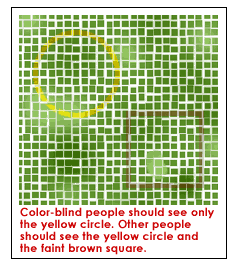Color Blindness Factsheet (for Schools)
What Teachers Should Know
Color blindness is caused by problems in the color-detecting nerve cells located in the back of the eye, called cones. As a result, some people have trouble telling the difference between red and green (the most common kind of color blindness), and between blue and yellow. Achromatopsia is a rare a form of color blindness in which people can't see any colors — they only see shades of gray.
Parents or teachers may suspect color blindness if a child seems to have trouble seeing certain colors. Kids and teens who are color blind have normal vision — they just don't see certain colors the way others do. A simple test can help identify color blindness.

Many people with color blindness don’t even know it. People who are color blind see normally in other ways and can do normal things, such as drive. They just learn to respond to the way traffic signals light up, knowing that the red light is generally on top and green is on the bottom. Some people can use special contact lenses and glasses to help them see some color differences, but there is no cure for color blindness.
Students who are color blind may:
- not be able to tell the difference between certain colors or shades of similar colors
- have trouble with assignments or projects that require them to use color
- need more light in the classroom and seating accommodations
- feel self-conscious or frustrated about not being able to see colors
- be teased or bullied because of color blindness
What Teachers Can Do
Getting to know and understand what color blind students can and cannot see — from parents or guardians, other teachers, and the student themselves — will help you understand and meet their needs much better. Color blind students may be eligible for a 504 plan, which can provide extra support.
Ways to help a student with color blindness include:
- writing in black on a whiteboard instead of using colors (or using white chalk on the blackboard instead of colored chalk)
- making copies of handouts with a high black/white contrast, and not on colored paper
- using patterns and/or labels in addition to colors
- writing out the names of colors if they are relevant to instruction (yellow sun, green frog, etc.)
- making sure art supplies or other supplies with colors are appropriately labeled
If you think a student may be color blind, talk to the family about getting their child tested.


